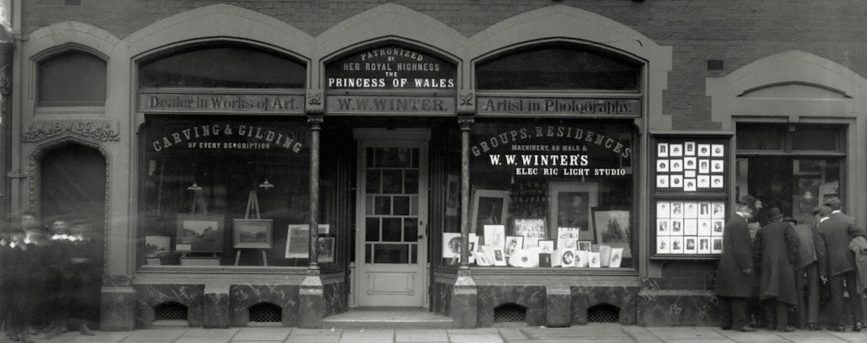This week Joanna talks about some of the information that can be found on artefacts, i.e. the prints in our collection.
When I am cataloguing prints I always turn them over to see what is written or printed on the back – usually it is the Winter’s business stamp, sometimes there is a name, date, title, negative number or random number (which in the future might mean something as we discover more). All these things are recorded. Cabinet cards which are photographs mounted on cardboard 8×6 inches (203x153mm) are printed with the photographer’s name on the front and designs on the back. When Mr Winter started winning medals in the 1880s the number of medals won, numbering over sixty, and the venues where the exhibitions took place were recorded. These ranged from across the UK to Europe, USA, and India .There is evidence that Mr Winter won his first award, a certificate for superior productions in photography in 1866 in Nottingham, his first medal came in 1884 at the Bedford Fine Art Exhibition with a print entitled ‘Meditation’. The top prize was a gold medal or a 1st silver medal followed by bronze medals and certificates. There were classes for professionals and amateurs. Classes included portraiture and landscapes, and single exhibits or groups.
During the last few weeks Angela and I have been trawling the newspaper archives and internet to find the names of the prints, exhibitions and details of the exhibits. The aim is to hopefully find the prints/plates relating to the exhibits. Names of prints include Miss Gibbs, Miss Beresford and her sister and Viola, but others have names which had me thinking ‘what’s in a name.’ There is ‘Amid the Bracken’, and Blushing Sixteen’ – some clues there! Then there is ‘Contemplation’, ‘A Quiet Moment’, ‘Undecided’, ‘A Reverie’, ‘Just Off’, and ‘The First Pipe’ reported as being ‘a juvenile act in 3 parts’. One wonders if this is about underage smoking! Two of the award winners ‘My Mammy’ and ‘Does Granny like Butter’ were registered for copyright and are in the National Archives so we can recognise them. Some are described in newspapers; ’The Undecided Voter’ is a portrait of a man sitting reading a paper and scratching his head. ‘The Poet and His Victim’, sometimes exhibited as ‘The Village Rhymester’, portrays two well-known Derby personalities George Miles (an insurance agent) and Samuel Borrey. The Sheffield Daily Telegraph gives an excellent description of the photograph. They are pictured in a snug room with a decanter of Madeira on the table and a pervading incense of tobacco. A man is reading to an elderly listener, Mr Borrey, asleep in a chair.
Mr Winter became renowned for his portraiture as is evident from the number of awards and accolades he received. Hopefully it will be possible to match the awards to the subjects as more plates are cleaned and catalogued.
